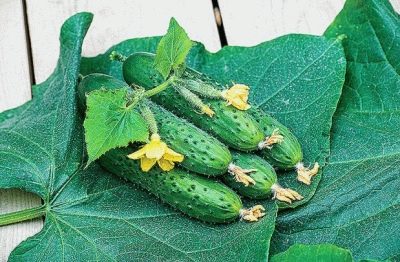
- Authors: SYNGENTA SEEDS B.V.
- Name synonyms: Spino
- Year of approval: 2015
- Growth type: indeterminate
- Fruit weight, g: 81-86
- Fruit length, cm: 12–14
- Fruit color: green, with medium stripes
- Cucumber Mosaic Virus Resistance: stable
- Ripening terms: early
- Fruit shape: cylindrical
Many gardeners and farmers are happy to grow early varieties of cucumbers, especially hybrids, since they are completely undemanding to care for, resistant to many diseases, and give high yields. A striking example of this is the Dutch variety Spino.
Breeding history
The Spino hybrid was obtained as a result of the work of the Dutch breeders of the agricultural firm Syngenta Seeds B. V. in 2013. On the territory of Russia, the vegetable crop is registered and entered in the register of approved for use in 2015. Recommended for growing cucumber in different climatic zones. The variety is maximally productive, growing in film greenhouses, as well as under film shelters. In addition, cucumbers are suitable for very early cultivation in heated greenhouse structures.
Description of the variety
The Dutch vegetable crop is a medium-sized shrub of an indeterminate type, which is characterized by medium climbing and moderate foliage with medium-sized green leaves. There are few side shoots in the bush.
A characteristic feature of the plant is the short internodes on the central stem, which contributes to the appearance of a huge number of ovaries. The flowering type of the plant is female, so there are practically no barren flowers. In the leaf nodes, 1-3 ovaries are formed.
Characteristics of the appearance of plants and zelents
Spino cucumbers stand out among their relatives for their aligned shape and attractive presentation. On average, the mass of a ripe vegetable is 81-86 grams, while the cucumber is shortened - up to 14 cm long. Ripe green is endowed with a uniform green color, diluted with light stripes. The shape of the vegetable is correct - cylindrical, sometimes resembling an oval. The skin of cucumbers is moderately dense, with medium tuberosity, pronounced pubescence and small thorns.
Zelentsy first grow in length and then in width, therefore they are not at all prone to overgrowth and deformation. In addition, the harvested cucumbers can easily be transported, and can also be stored for a long time - up to 8-10 days in a cool place.
Purpose and taste of fruits
The vegetable is famous for its excellent taste. The pulp of zelents is dense, fleshy, tender and very juicy, without bitterness and wateriness. The taste is dominated by pleasant sweetness, complemented by a bright, summer aroma. Fresh vegetable is endowed with a pleasant crunch. The seeds in the pulp are small, they are not felt at all when eaten.
The purpose of the vegetable is universal - it is eaten fresh, added to salads, canned, pickled, salted.
Maturation
The Spino variety is early maturing. From the moment of emergence of mass shoots to ripe zelents, 39-40 days pass. The ripening of the culture is friendly, therefore it is recommended to choose cucumbers every day. With an early spring planting, 2-3 weeks pass from flowering to ripening of cucumbers, and with a summer planting - 10-15 days. The advantage of the variety is considered to be stable fruiting. The mass harvest takes place at the end of June - beginning of July.
Yield
The variety is claimed to be high yielding.On average, about 16 kg of greenery can be harvested from 1 m2 of plantings.
Landing scheme
When planting cucumber seedlings, you should keep the distance between the bushes. It is recommended to plant 2-3 bushes per 1 m2, no more. The 60x30 cm scheme is considered the best for planting.
Growing and care
Planting seedlings in a greenhouse is carried out in the second half of May. Suitable for planting healthy seedlings with 3-4 true leaves and a strengthened central stem.
Cultural agrotechnics consists of basic activities - irrigation with warm water (drip system), top dressing every 2 weeks, tying bushes, hilling, removing weeds, disease prevention.
Soil requirements
It is comfortable for the plant to grow on loose, nutritious, non-acidic soils with good air / moisture permeability. Optimally, these are sandy loam and loamy soils.

In order to collect strong, tasty and beautiful cucumbers on your site, you need to make top dressing. Lack of nutrients can negatively affect the appearance of the plant and significantly reduce the yield. Fertilize cucumbers with organic fertilizers in combination with mineral fertilizers. With the right balance of these components and adherence to the fertilizing schedule, the cucumber yield will be maximum.
Required climatic conditions
The Dutch cucumber is quite stress-resistant, due to which it is able to develop and bear fruit in low light, and tolerate temperature fluctuations. It should also be borne in mind that cucumbers love light, warmth, space, but are very susceptible to drafts.
Disease and pest resistance
Thanks to its strong immunity, the plant is able to withstand many diseases - cladosporium, cucumber mosaic virus, powdery mildew. In addition, the culture is resistant to cucumber vein yellowing virus and downy mildew.

Despite their popularity, cucumbers are often attacked by diseases and pests. From them, cucumber plantings often die before the start of fruiting. In order to prevent this from happening, it is necessary to try to prevent ailments or get rid of them at the very beginning, having studied in detail their causes of occurrence, signs and methods of treatment.





























































































